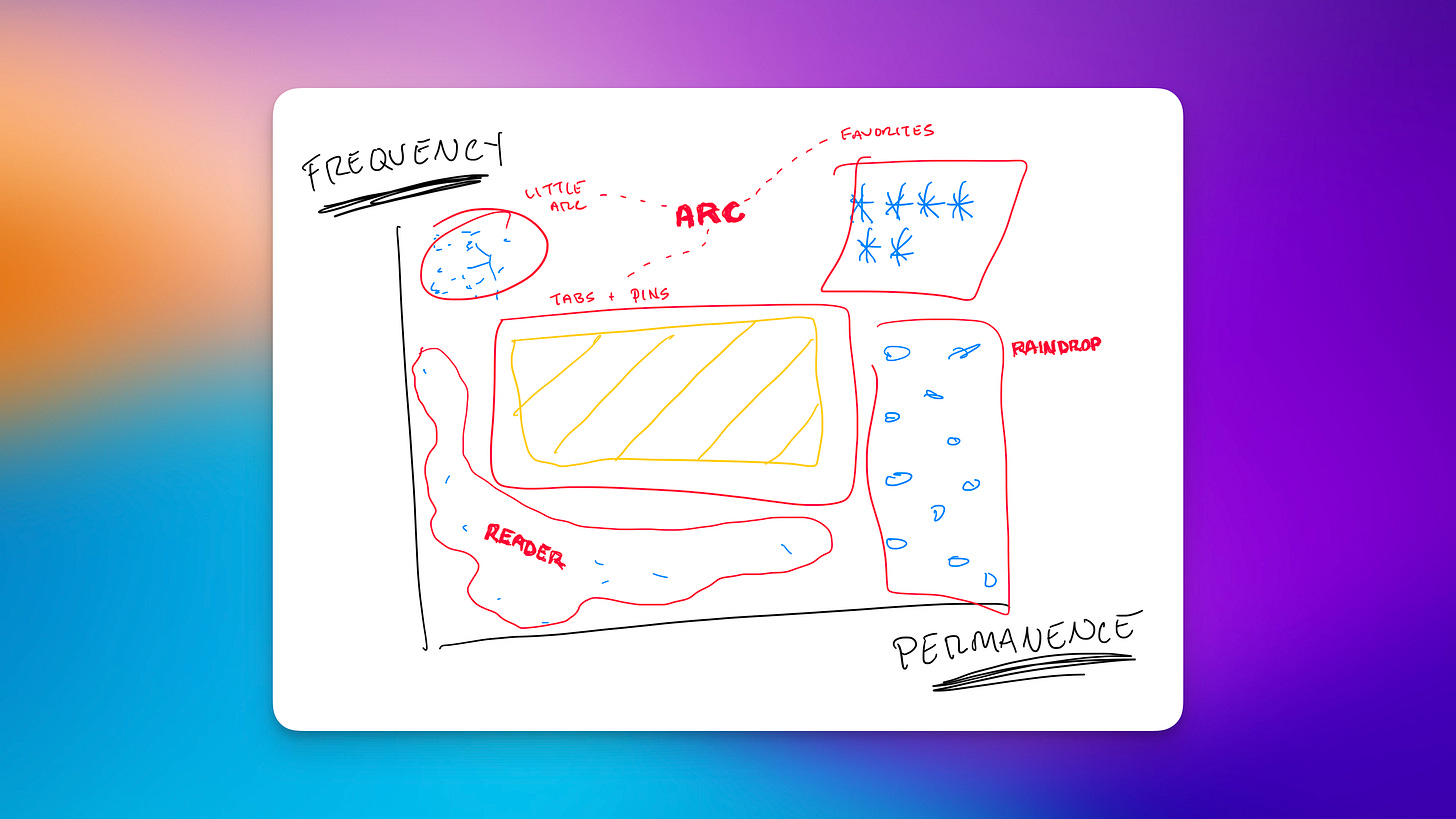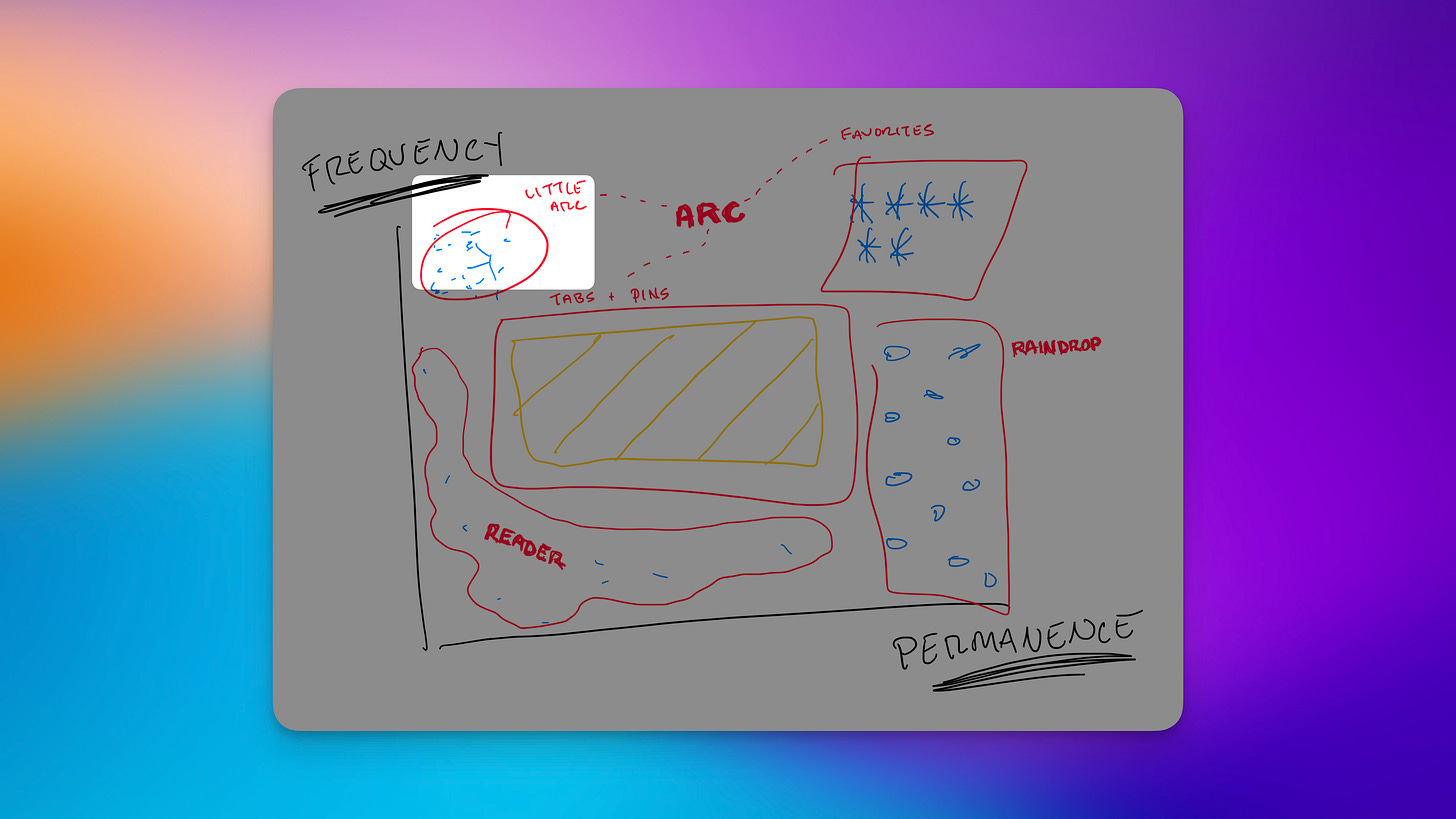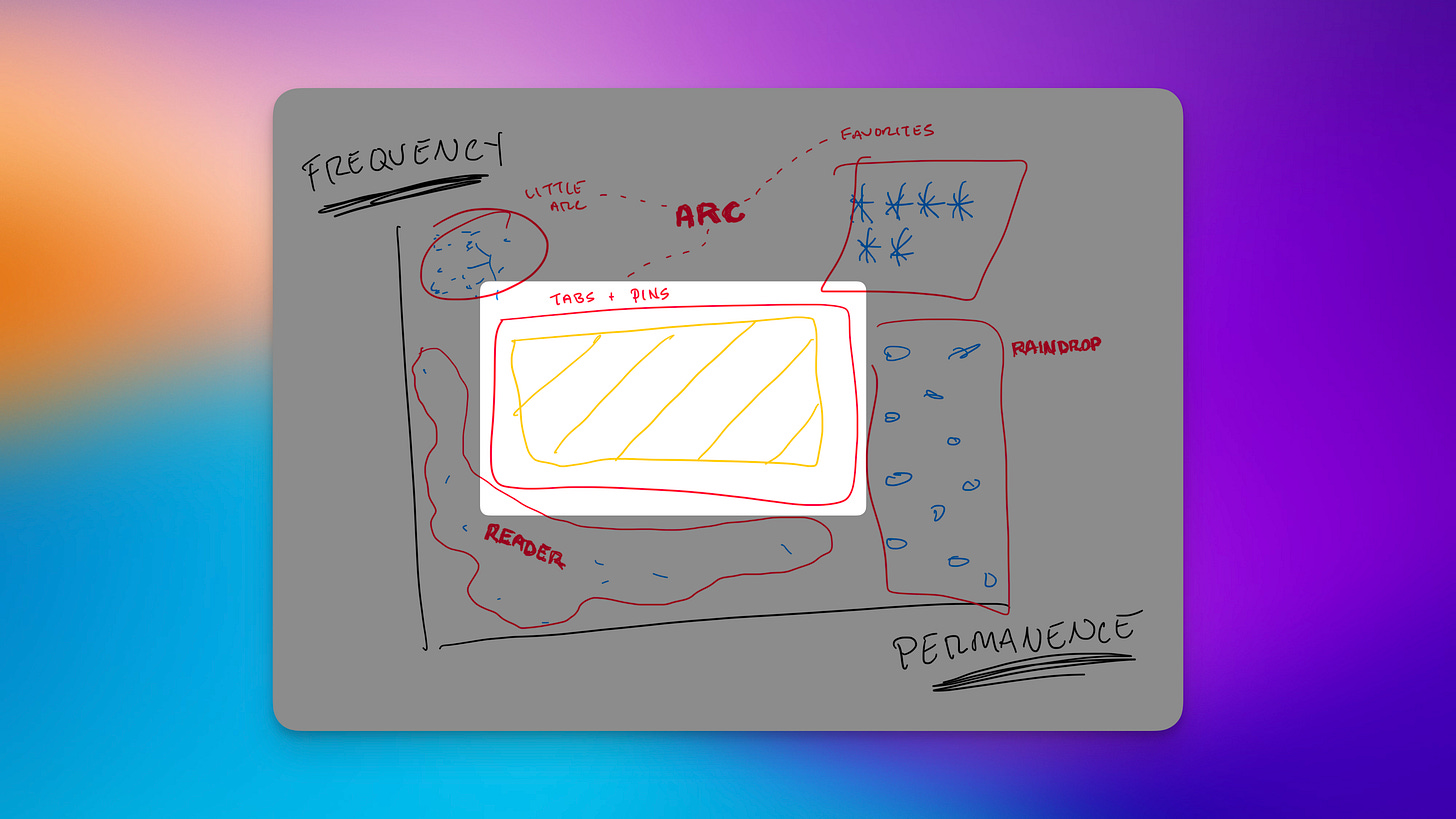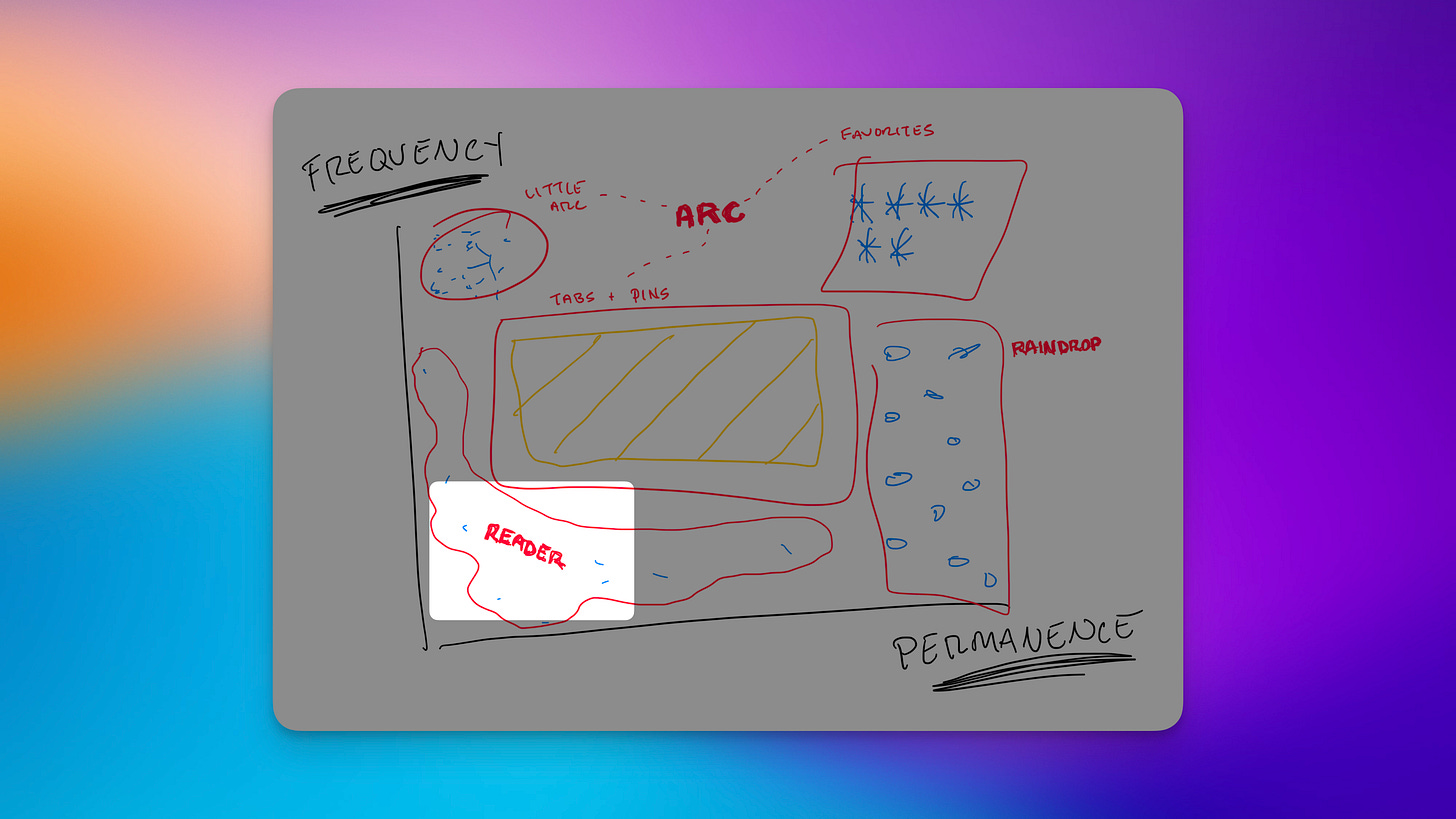How to Fix Tab Overload
A new mental model to help you choose better tools for managing links
We were all running around and laughing when we heard it. At first, it was too quiet to discern what the sound was. I moved toward it slowly, but stopped short when it came again - a scream. This time I ran. As I came close to the retention pond I could barely see the other side with all the reeds towering above me. What I could see was the brick wall that surrounded a neighboring subdivision. I strained my neck to find a better view when suddenly the reeds on the other side of the pond began thrashing violently and then that piercing scream again.
I snapped around to realize that the whole gaggle of neighborhood kids had followed me down here. I quickly scanned for the face of my little sister. Was that her screaming? No, she was there with me, her little body shaking and her glassy eyes reflecting the same fear that made my own body feel like ice.
"That's the alligator pond!" one child hollered.
We needed a grown-up. Now.
I ran back toward our apartments screaming for help then waited helplessly as one of the parents ran around the pond to investigate. My young mind raced with vivid imaginings of sheer carnage. It felt like we waited there for an hour. When the adult finally returned alone I was sure that someone had died.
"We were too late..."
Present Day
Spoiler alert! No one died. No one was hurt. I'm not even sure there was an alligator in that pond. We learned that the little girl had managed to climb over and fall off the brick wall that separated her backyard from the pond. The grown-up was able to untangle her from the reeds, but the child was too young to know where she lived. They had to go door-to-door before finally finding her mother who hadn't even realized she was missing.
Addresses
Back then, this whole ordeal provided a great teaching moment for all the parents:
"Memorize our address and home phone number."
"Stay inside the sidewalk line that circles our block."
"Come in when the street lights come on."
"No code. No go. Apple bottom."
Things have changed a lot since then. The migration of nearly every component of my life from analog to digital is almost funny to think about. Back then, there were physical addresses of the places I frequented, home phones tethered to someone's wall, and the dewey decimal system - fixed coordinates for static places with tangible bounds. Now it's deep links, URLs, and handles - all dynamic, constantly in flux, moving.
P.S. - If you wanna go deep on the intersection of our physical and digital lives, Drew Austin has a killer newsletter that blows my mind every time: Kneeling Bus.
So how do we wrangle the madness that is our list of web addresses? How do we find what we’re looking for when we’re looking for it? How do we cut the cruft when an address is no longer meaningful to us?
First, I want to point out how absolutely WILD it is that this even a relevant topic at this point. I grew up in the 90’s. I haven’t touched a landline in over a decade. My kids have never known a world without high-speed internet in your pocket let alone on a computer.
So why is tab overload still a thing???
Digital [Il]literacy
There's a term called digital literacy and Wikipedia defines it as:
An individual's ability to find, evaluate, and communicate information using typing or digital media platforms. It is a combination of both technical and cognitive abilities in using information and communication technologies to create, evaluate, and share information.
We're living in an explosive time in terms of technological advancement, which means there are lots of new technologies at our disposal from which we can "create, evaluate, and share information." Things are constantly changing and we're having to constantly change to keep up.
And if we go by this definition, we've only been in this period of transition for about 40 years! That may sound like a long time, but it terms of human history it's almost nothing. Even in comparison with more recent technological advancements it's not that long.
High-Tech: Railroads and Telephones
I liken this to railroads and telephones in America. Those technologies completely changed society, but it took time to build the infrastructure and time for society to acclimate to it.
Regarding railroads, Wikipedia states:
The American railroad mania began with the founding of the first passenger and freight line in the country, the Baltimore and Ohio Railroad, in 1827
and
By 1880 the nation had 17,800 freight locomotives carrying 23,600 tons of freight, and 22,200 passenger locomotives. The U.S. railroad industry was the nation's largest employer outside of the agricultural sector. The effects of the American railways on rapid industrial growth were many, including the opening of hundreds of millions of acres of very good farm land ready for mechanization, lower costs for food and all goods, a huge national sales market, the creation of a culture of engineering excellence, and the creation of the modern system of management.
It took about 50 years to get the infrastructure (and all the other systems that that entailed) in place at scale, which brought increasingly lower costs, greater access, and greater societal impact. That's five decades for our society to adopt a new technology that fundamentally altered how we move stuff across greater and greater distances.
Regarding telephones, Wikipedia states:
The telephone played a major communications role in American history from the 1876 publication of its first patent by Alexander Graham Bell onward
and
In 1890, 1 percent of U.S. households owned at least one telephone while a majority did by 1946 and 75 percent did by 1957
This time it took roughly 80 years to get things all laid out for widespread usage of a technology that would make it easier and cheaper than ever to share ideas across any distance.
Going back to that article by the University System of Georgia:
January 1, 1983 is considered the official birthday of the Internet. Prior to this, the various computer networks did not have a standard way to communicate with each other. A new communications protocol was established called Transfer Control Protocol/Internetwork Protocol (TCP/IP).
Wikipedia states:
The Internet's takeover of the global communication landscape was rapid in historical terms: it only communicated 1% of the information flowing through two-way telecommunications networks in the year 1993, 51% by 2000, and more than 97% of the telecommunicated information by 2007
By this math, we saw a major shift from the implementation of this new technology called "the internet" within 30 years. However, I remember using the internet in 2007 and it sucked ass.
I'd argue that, between fiber optic, 5G networks, and Starlink, we're only just NOW beginning to enjoy the broader benefits of internet infrastructure at scale. Hence the explosion of things like VR headsets, the internet of things, and (perhaps most notably) large language models (LLMs). The internet (ok, and processing power) have now gotten cheap enough (and small enough) to really open up vastly new ways of operating as a society.
We're effectively 40 years into this ordeal whereas it took us 50 years and 80 years for railroads and telephones respectively. We're still learning this thing. We're still developing our digital literacy skills. And we still don't know what the fuck we're going to do with all of those open tabs in Chrome.
A New Paradigm
I'd like to propose a structured way of looking at links that has helped me refine my skills when it comes to managing URLs. In other words, this mental model has helped me choose the right "technologies to create, evaluate, and share information".
How to Categorize Links
My "matrix" works off of the two most important properties of any given link:
Frequency: "How many times do I access this link per day? per week? per year?
Permanence: "Will I care about this link a year from now? Next month? In 5 minutes?
How to Find Tooling
Based on where a given link fits on the graph, I'd posit that it merits very different tooling based on the relevance of the following factors in interacting with said link:
Accessibility: "How much friction can I tolerate in accessing this link?"
Organization: "How well will I remember where I put this link?"
Context: "How much will I remember about the significance/utility of this link?"
Clean-up: "How easy do I want it to be to delete this link?"
What I'm going to use the rest of this article to accomplish is to show you how I categorize links and how I chose the tools I use. The tools I use don't ultimately matter. What's important is how I selected the tools I chose. If any of the tools I highlight seem like a fit with your personal way of working, great! If not, also great! My goal is to give you a mental model to help shape the way you interact with the internet so that you can be more intentional and have more fun (and less stress!).
My Tools
TL;DR
If you're just here for the tools, here they are! Arc for browsing, Raindrop for an additional layer of bookmark management, and Reader as my read-it-later app of choice. Skip to the bottom for a video tour of all three.
High Permanence, High Frequency
Like my wallet, phone, and keys - I give myself a quick pat-down before I leave the house and then I can pull any one of these out without ever looking
These links are here for the long haul and they will get beat to death. Whatever system you use to access these needs to be easy-to-use and rugged as hell.
Accessibility: High
Because I'm using these multiple times every day, any friction in accessing them will compound over time...quickly.
Organization: Low
I reap the benefits of muscle memory on this one. The more I use these links the more ingrained their location becomes in my memory.
Context: Low
Again, because I'm getting so much practice in using these, the smallest visual clue isn't even necessary. I really just need something big enough to click/tap and in a fixed position over time.
Clean-Up: Low
Don't touch my links, bro! These are permanent fixtures, so it can be a total pain in the ass to delete them - I'll never know.
Low Permanence, High Frequency
The butt-wipes of the web - I use 'em once and toss 'em. Depending on the day (and my fiber intake), this could happen a LOT.
You want tooling here that's just as easy to delete as it is to open. Things like finding that meme, or looking up that keyboard shortcut, or converting teaspoons to ounces, or looking up the time in PST.
Accessibility: High
I have a quick question and I want a quick answer. Double-points for a global keyboard shortcut here.
Organization: Low
What's to organize? This link is useful for as long as it takes you to read the answer it displays.
Context: Low
Again, you're never going to see this link again - you've brought the context with you.
Clean-Up: High
This is crucial. Let these links die. They've had their time and now it's time for URL heaven.
High Permanence, Low Frequency
That one really nice outfit you had to wear to weddings and funerals as a kid. You know, the one that your mom would murder you over if anything happened to it.
There are a lot of really fun use cases for this one. Like my list of favorite apps, and my list of favorite gear. I even do my family wishlists this way!
The most important thing here is that these links are important, but the low frequency of access means you're probably going to forget a lot about them. You need systems in place to augment this for you.
Accessibility: Low
Low frequency means that I won't mind a little friction. We've got room to optimize for context here, so it's probably best to deviate from your browser on this one.
Organization: High
Low frequency = less memory practice = more forgetting = we need some powerful search up in this bitch! Double-points for tags and other searchable metadata.
Context: High
"I saved this link a year ago and marked it #important, but what the hell for!?"
...Don't be that guy.
Clean-Up: Low
The low accessibility of this tool will lend to you being more selective about what you put in it, so deleting things will be less important.
The Sweet Spot
The perfect ratio of milk to breakfast cereal. This one's pretty personal and totally depends on your life at that moment.
I treat this one as a catch-all of sorts because it can be really different if I'm on my phone vs. computer, focused on a project vs. trying to learn something new.
Side Note
When it comes to milk and cereal, I want to go on record as saying that the sequence is always cereal first, THEN the milk. Folks who pour the milk in first are probably murderous psychopaths and if that is you, please seek help.
This is the area that I feel most browsers are actually built to handle. Tabs for things you need to keep referencing throughout the day, but don't need tomorrow. Bookmarks for the things you want to keep around a little longer.
Accessibility: Medium
Because I see this as the realm of daily "work", this should be quick and easy to access, but not at the expense of good organization and clean-up.
Organization: Medium
I really appreciate some good hierarchal layering here. I'm using these links pretty regularly, so I can even go pretty deep with nesting this stuff. The trick is being able to switch between multiple links quickly here.
Context: Medium
Again, there's enough frequency here to limit the need for a ton of context. However, double-points if you can use a tool to help you organize these by high-level contexts or "areas" (ex. these bookmark folders are for this project, these folders are for this other project). I love browsers like Arc, Vivaldi, and Stack for this.
Clean-Up: Medium to High
This is the hardest part of this whole mental model. I suggest finding a tool that will close all of your tabs at a set cadence so that it forces you to organize a link or let it die. You'll waste way more time trying to find links buried in your sea of tabs every day than you will looking for the occasional deleted tab in your browser history.
Unknown Permanence, Unknown Frequency
A digital mailbox...but for links...and not for email.
Ok, look, I know email is literally a digital mailbox, but I really like this analogy here and I hate email, so please just let me have this!
This is for all of those links you get from bloggers, news outlets, and (if you're really cool) RSS feeds. You don't know if it's great or if it's trash, but you don't have time to find out right now. So you need an inbox and a way to parse it later. This is why I think read-it-later apps can be so great.
Accessibility: Low
These kind of links can be a real time suck and make for a great distraction when you're trying to write that blog post on URLs that you've been trying to finish for days. You want to be able to send these links away for parsing later and DON'T want them to be easy to get to. Double-points for share extensions and browser plugins.
Organization: Low
This is more of an inbox model, so some organization is good, but it's best to keep this more fluid. Double-points for tagging, assistive organization features, and killer search.
Context: High
Depending on how often you go through this inbox, context could help you parse these faster. Double-points for AI summaries, especially when you follow authors with ultra-cheeky titles and summaries.
Clean-Up: High
This one has the potential to become a total shit-show. I HIGHLY recommend purging your collection of subscriptions as part of the setup process for any new app in this category. Ask yourself, "Do I actually want to read this person's stuff? Or do I feel like I should read their stuff?"
“Should read”!?
Fuck that.
Reading “should” be fun.
Have fun and unsubscribe away.
Summary
I hope this article helped you think of links in a new way and maybe even gave you some practical ideas about how you can be more intentional about your usage of links across your digital life. If you'd like to see a more in-depth look at how I use the tools I described above, you can check out the video below.









